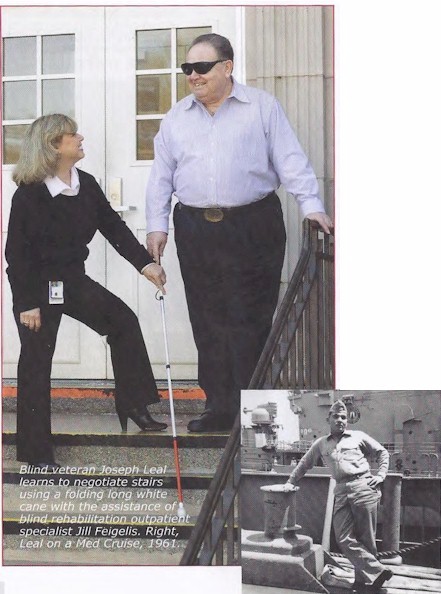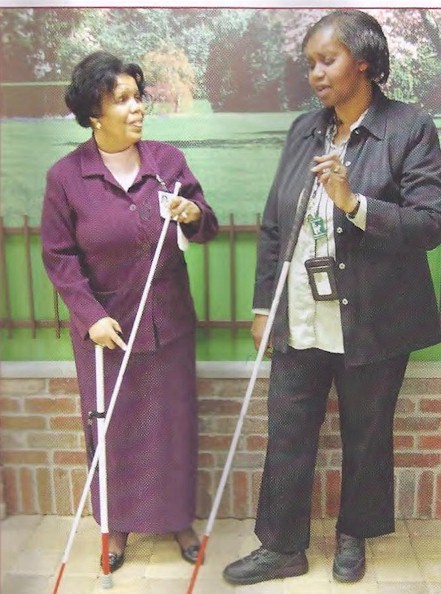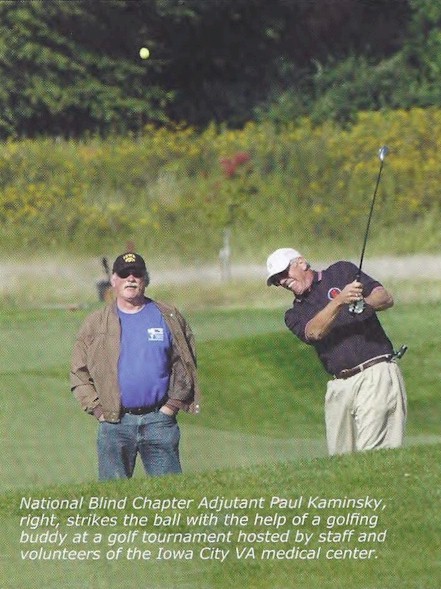"The incidence of blindness and age-related diseases are growing as our
veteran population ages," said Washington Headquarters Executive Director Barry
Jesinoski “The DAV supports VA training programs provided by 157 visual-impairment
service teams, who provide case management, and 77 blind rehabilitation outpatient
specialists, who offer in-home and in-community service. They help provide safe
independent living for blind veterans. One of the most important tools is the white cane,
coupled with adequate training."
Jill Feigelis, a blind rehabilitation outpatient specialist at the East Orange, N.J., VA
medical center, said the white cane carries the weight of law. "It protects the
blind, and the power of the courts enforces that," she said. "It's almost like
the flag for blindness, but the only place people learn about it today is in a state
driving manual?
There are essentially two types of white canes used by the VA. Most blind persons prefer
the long folding cane which can have a special tip either for tapping or rolling,
depending on how they use the cane. There is also the support cane which is shorter
and used by the blind who also have balance problems that can result in falls. All are
white with a red tip, which is the U.S. standard.
"Once a veteran receives a white cane, I always educate them about the white cane law
and how they are now an advocate along with their family and friends to educate the public
about this law," Feigelis said. "My goal is to have everyone aware of the white
cane law. The visually impaired and blind person is doing their part to alert the public
that they cannot see very well. It is the sighted public's responsibility to respect and
abide by the white cane law."
But any VA blind rehabilitation worker will say that it takes a little work to operate the
cane and to become confident in its protection. "Most of us would like people to
recognize the cane as specific for identification purposes, said Cecelia Rose, the blind
rehabilitation outpatient specialist at the Washington, D.C., VA medical center.
Rose's colleague, vision rehabilitation supervisor Lillie Kennedy, who is blind herself,
works with about I blind and legally blind veterans. She says the training is based
on individual goals, vision loss, length of training and the desire for knowledge.
"It's a big adjustment for families and for blind people to use a cane," she
said. "But nothing changes because you're blind. You still have to buy the groceries
and pay the mortgage."
"VA care is stupendous," said Leal. "It is really something that is very
positive in my life since I lost much of my eyesight. They have the Visor program to admit
you as a patient for 10 days and they teach you everything you need to know as a legally
blind person."
And sometimes, blind veterans, readily recognized by their white canes, are easy prey for
criminals. "We teach our blind veterans to protect themselves," said Kennedy.
"We teach them how to fall, because they are an easy target. But by teaching them
blind Judo to defend themselves, we give blind veterans more confidence."
Still, Kennedy said there's the stigma of the white cane. "It makes you uncomfortable
when people stare at you," she said. "Sighted people rarely know what to say or
how to interact with the blind. It's like they expect me to walk into a wall."
The New Jersey VA hosts electronic billboard announcements to abide by the white cane
law as well as advocacy days that inform the public about the law. White Cane Safety Day,
Oct. 15, is conducted at every VA facility across the nation.
"The goal of an Orientation and Mobility Specialist (O&M) is to help a legally
blind and blind individual to move in space and travel safely and independently in their
daily routine," said Feigelis. "Upon evaluation by an instructor, they are
issued a white cane and provided instruction on its use.
"The O&M instructor can train the visually impaired and blind person to
independently travel around their home to stores, shopping, and to take public
transportation," said Feigelis. "The extension of the long white cane provides
reaction time so that the cane hits the problem before the individual, thereby reducing
falls and providing safety."
"We support the VA's comprehensive in-patient Blind Rehabilitation Centers across the
nation," said Jesinoski.
"We really appreciate the visual impairment services team coordinators and the
blind rehabilitation outpatient specialists who train our veterans to use white canes.
"Sadly, VA Palo Alto Polytrauma Rehabilitation Center studies have determined that 75
percent of veterans diagnosed with traumatic brain injury, a frequent injury of the wars
in Iraq and Afghanistan, also suffer from vision problems," Jesinoski said.
"More than half were unable to interpret print, and 4 percent were legally blind.
Nearly 2,100 veterans of these wars enrolled in the VA are blind or have low vision."
Leal said it is best for the public to know that there are a lot of blind people walking
the streets. "They have to be aware that we have a handicap and they should
acknowledge that we need the room."
"If somebody sees that white cane, they want to help you," Leal said. "I
don't think there's enough education out there to tell people to yield to the blind.
"Blind veterans rarely ask for assistance. "We depend on our hearing, and we
know the difference between the sidewalk and grass. We can feel the cracks in street
pavement. But if someone offers help, I welcome it."
"I want the public to be more aware of the reason for the white cane and to respect
it and the person using it, because they are the same person as before. They just don't
see," said Feigelis. "They are still that wonderful person you knew before, and
they do not want to be a burden to anyone.
"You can't take the pride away from veterans," she said. "You must give
them their dignity."
"When you see a blind person, introduce yourself and ask if assistance is needed,
especially when a person looks lost or in need of assistance, such as walking slow,
looking around, or looking bewildered," said Kennedy.
"There are alotofmobilityproblemswithblindness," said Kaminsky. "It is a
different, dark world. Many of our sister DAY Chapters make financial donations to the
National Blind Chapter to assist our blind veterans attend the VA rehabilitation centers.
"We use the funds at mobility centers, get veterans out to shop, eat and attend
events during the weekends they are there," he said. "That's what our Chapters
do for us. DAV Chapters are exemplary in taking on the hard work for our blind members who
can't do fundraising on their own."


